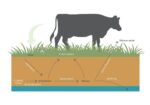Dairy committed to a better environment
DairyNZ says today’s Environment Aotearoa 2019 report gives honest insight into New Zealand’s environment and where the opportunities lie for the dairy sector, particularly for water quality, biodiversity and climate change. Strategic leader for DairyNZ’s environmental portfolio, Dr David Burger, said while the report shows the dairy sector has work to do, there is no doubt farmers are working hard to look after the environment – with significant work already undertaken over the last 10 years to improve environmental practices across New Zealand. “The Environment Aotearoa report helps us understand the changes over time. There are some areas where more work needs to happen or where current initiatives will take time to deliver results,” said Dr Burger. “There is also an opportunity for the dairy sector, government and conservation groups to work more closely together to support farmers in making changes and understanding the effects downstream. For example, in Southland’s Aparima Catchment we are working closely with all land users to collectively improve the estuary. “Dairy has a clear vision – we all need to improve our environment and that’s why we’re actively in the community, talking about the role we all play. We have been on a journey for many years to look after the environment, and we will continue that good work. Cow numbers have now stablilised so our focus is managing our farm systems more sustainably. “We farm in areas of immense cultural value, as well as where people come to connect and play. Our farmers take their responsibilities seriously and are working toward leaving the environment in a better state. We know this will take time but we are committed to this kaitiaki.” The Dairy Tomorrow sector strategy launched in 2017 includes a strong commitment by dairy to protect and nurture the environment for future generations, […]










